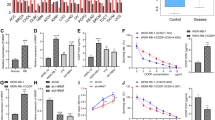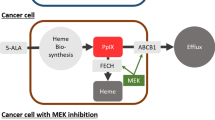Abstract
Photodynamic therapy (PDT), a promising new therapeutic modality for the management of a variety of solid malignancies and many non-malignant diseases, is a bimodal therapy using a porphyrin based photosensitizing chemical and visible light. The proper understanding of the mechanism of PDT-mediated cancer cell-kill may result in improving the efficacy of this treatment modality. Earlier we have shown (Proc. Natl. Acad. Sci. USA; 95: 6977-6982, 1998) that silicon phthalocyanine (Pc4)-PDT results in an induction of the cyclin kinase inhibitor WAF1/CIP1/p21 which, by inhibiting cyclins (E and D1) and cyclin dependent kinases (cdk2 and cdk6), results in a G0/G1-phase arrest followed by apoptosis in human epidermoid carcinoma cells A431. We have also demonstrated the generation of nitric oxide during PDT-mediated apoptosis (Cancer Res.; 58: 1785-1788, 1998). Retinoblastoma (pRb) and E2F family transcription factors are important proteins, which regulate the G1→S transition in the cell cycle. Here, we provide evidence for the involvement of pRb-E2F/DP machinery as an important contributor of PDT-mediated cell cycle arrest and apoptosis. Western blot analysis demonstrated a decrease in the hyper-phosphorylated form of pRb at 3, 6 and 12 h post-PDT with a relative increase in hypo-phosphorylated pRb. Western blot analysis also revealed that PDT-caused decrease in phosphorylation of pRb occurs at serine-780. The ELISA data demonstrated a time dependent accumulation of hypo-phosphorylated pRb by PDT. This response was accompanied with down-regulation in the protein expression of all five E2F (1 – 5) family transcription factors, and their heterodimeric partners DP1 and DP2. These results suggest that Pc4-PDT of A431 cells results in a down regulation of hyper-phosphorylated pRb protein with a relative increase in hypo-phosphorylated pRb that, in turn, compromises with the availability of free E2F. We suggest that these events result in a stoppage of the cell cycle progression at G1→S transition thereby leading to a G0/G1 phase arrest and a subsequent apoptotic cell death. These data provide an evidence for the involvement of pRb-E2F/DP machinery in PDT-mediated cell cycle arrest leading to apoptosis.
This is a preview of subscription content, access via your institution
Access options
Subscribe to this journal
Receive 50 print issues and online access
$259.00 per year
only $5.18 per issue
Buy this article
- Purchase on Springer Link
- Instant access to full article PDF
Prices may be subject to local taxes which are calculated during checkout





Similar content being viewed by others
References
Agarwal ML, Clay ME, Harvey EG, Evans HH, Antunez AR and Oleinick NL. . 1991 Cancer Res. 51: 5993–5996.
Agarwal ML, Larkin HE, Zaidi SIA, Mukhtar H and Oleinick NL. . 1993 Cancer Res. 53: 5897–5902.
Agarwal ML, Taylor WR, Chernov MV, Chernova OB and Stark GR. . 1998 J. Biol. Chem. 273: 1–4.
Agarwal R, Korman NJ, Mohan RR, Feyes DK, Jawed S, Zaim MT and Mukhtar H. . 1996 Photochem. Photobiol. 63: 547–552.
Ahmad N, Feyes DK, Agarwal R and Mukhtar H. . 1998 Proc. Natl. Acad. Sci. USA 95: 6977–6982.
Ben-Hur E, Oetjen J and Horowitz B. . 1997 Photochem. Photobiol. 65: 456–460.
Bowen C, Spiegel S and Gelmann EP. . 1998 Cancer Res. 58: 3275–3281.
DeGregori J, Leone G, Ohtani K, Miron A and Nevins JR. . 1995 Genes Dev. 9: 2873–2887.
Dougherty TJ, Gomer CJ, Henderson BW, Jori G, Kessel D, Korbelik M, Moan J and Peng Q. . 1998 J. Natl. Cancer Inst. 90: 889–905.
Duronio RJ, Brook A, Dyson N and O'Farrell PH. . 1996 Genes Dev. 10: 2505–2513.
Gartenhaus RB, Wang P and Hoffmann P. . 1996 Proc. Natl. Acad. Sci. USA 93: 265–268.
Goldberg Y, Nassif II, Pittas A, Tsai LL, Dynlacht BD, Rigas B and Shiff SJ. . 1996 Oncogene 12: 893–901.
Gomer CJ, Ryter SW, Ferrario A, Rucker N, Wong S and Fisher AM. . 1996 Cancer Res. 56: 2355–2360.
Gomer CJ. . 1991 Photochem. Photobiol. 54: 1093–1107.
Granville DJ, Levy JG and Hunt DWC. . 1997 Cell Death Diff. 4: 623–626.
Gupta S, Ahmad N and Mukhtar H. . 1998 Cancer Res. 58: 1785–1788.
He J, Whitacre CM, Xue LY, Berger NA and Oleinick NL. . 1998 Cancer Res. 58: 940–946.
Hiebert SW, Chellappan SP, Horowitz JM and Nevins JR. . 1992 Genes Dev. 6: 177–185.
Ho YS, Wang YJ and Lin JK. . 1996 Mol. Carcin. 16: 20–31.
Hsu CA, Rishi AK, Su-Li X, Gerald TM, Dawson MI, Schiffer C, Reichert U, Shroot B, Poirer GC and Fontana JA. . 1997 Blood 89: 4470–4479.
Ishida A, Sasaguri T, Kosaka C, Nojima H and Ogata J. . 1997 J. Biol. Chem. 272: 10050–10057.
Kasten MM and Giordano A. . 1998 Cell Death Diff. 5: 132–140.
Lam EW and La Thangue NB. . 1994 Curr. Opin. Cell. Biol. 6: 859–866.
Lam EW and Watson RJ. . 1993 EMBO J. 12: 2705–2713.
Linke SP, Harris MP, Neugebauer SE, Clarkin KC, Shepard HM, Maneval DC and Wahl GM. . 1997 Oncogene 15: 337–345.
Luna MC, Wong S and Gomer CJ. . 1994 Cancer Res. 54: 1374–1380.
Luo Y, Chang CK and Kessel D. . 1996 Photochem. Photobiol. 63: 528–534.
Morgan DO. . 1995 Nature 374: 131–134.
Muller R. . 1995 Trends Genet. 11: 173–178.
Oleinick NL, Antunez AR, Clay ME, Rihter BD and Kenney ME. . 1993 Photochem. Photobiol. 57: 242–247.
Pass HI. . 1993 J. Natl. Cancer Inst. 85: 443–456.
Ryter SW and Gomer CJ. . 1993 Photochem. Photobiol. 58: 753–756.
Separovic D, He J and Oleinick NL. . 1997 Cancer Res. 57: 1717–1721.
Sherr CJ. . 1993 Cell 73: 1059–1065.
Tao J, Sanghera JS, Pelech SL, Wong G and Levy JG. . 1996 J. Biol. Chem. 271: 27107–27115.
Taya Y. . 1997 Trends Biochem. Sci. 22: 14–17.
Tom R. . 1997 J. Natl. Cancer Inst. 89: 112–114.
Weinberg RA. . 1995 Cell 85: 457–459.
Weinberg RA. . 1996 Cell 81: 323–330.
Weintraub SJ, Chow KN, Luo RX, Zhang SH, He S and Dean DC. . 1995 Nature 375: 812–815.
Zaidi SIA, Oleinick NL, Zaim MT and Mukhtar H. . 1993 Photochem. Photobiol. 58: 771–776.
Acknowledgements
This study was supported by USPHS grants RO1 CA 51802, PO1 CA 48735, P30 CA 43703 and P30 AR 39750.
Author information
Authors and Affiliations
Rights and permissions
About this article
Cite this article
Ahmad, N., Gupta, S. & Mukhtar, H. Involvement of retinoblastoma (Rb) and E2F transcription factors during photodynamic therapy of human epidermoid carcinoma cells A431. Oncogene 18, 1891–1896 (1999). https://doi.org/10.1038/sj.onc.1202493
Received:
Revised:
Accepted:
Published:
Issue Date:
DOI: https://doi.org/10.1038/sj.onc.1202493
Keywords
This article is cited by
-
Interleukin-6 trans signalling enhances photodynamic therapy by modulating cell cycling
British Journal of Cancer (2007)
-
Involvement of nuclear factor-kappa B, Bax and Bcl-2 in induction of cell cycle arrest and apoptosis by apigenin in human prostate carcinoma cells
Oncogene (2002)
-
In vitro and in vivo inhibition of epidermal growth factor receptor-tyrosine kinase pathway by photodynamic therapy
Oncogene (2001)



